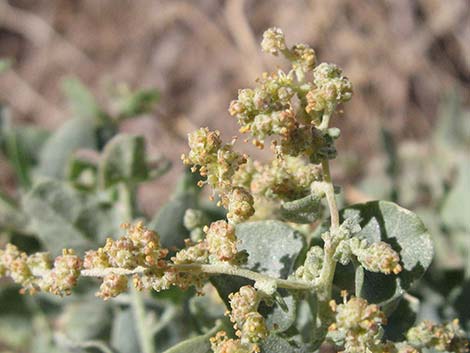The Quailbush

WHAT WETLANDS PARK PLANT HAS MORE THAN 27 RELATIVES IN THE STATE OF NEVADA (AND TASTES LIKE POPCORN)?
When walking the Clark County Wetlands Park Nature Preserve, it’s hard not to see a quailbush (Atriplex lentiformis) on the trails where there is some availability of water. These shrubs are usually wider than tall, featuring many spreading branches that become spiny and dense as they mature. If there is an abundant supply of water, the bushes can grow up to 11 feet high! Apparently, there are 27 species in the quailbush genus within the state. Maybe on your next walk in the Park, you can spot some of these “relatives?
The quailbush, also known as “Big Saltbush,” is hardly showy. Its drab, gray-green leaves are oblong. On the lower epidermis (underside of the leaf), small crystals of salt may be present. The size of the plant’s leaves and color and size of its flowers and fruit will vary by species, availability of water and other growing conditions, and the plant’s sex. The bush is extremely tolerant of harsh conditions (such as those found in southeastern Nevada), including alkalinity, salinity, heat, cold, and drought. It is an excellent wildlife plant, attracting a wide variety of birds, small mammals, and insects for both its abundance of seeds and shelter. In the Park, quailbush attract Gambel’s quail, roadrunners, white-crowned sparrows, and other seed-eating birds; cottontail and jack rabbits; and many other critters, including rodents like southern grasshopper mice, kangaroo rats, desert woodrats, and roundtail squirrels and insects like saltbush sootywing and pygmy blue butterflies.
Quailbush may be dioecious, meaning individual plants bear either male or female flowers or it can be monoecious, meaning the plant has both male and female flowers. Either way, male pollen (from male flowers, see picture above is required for female flowers to bear fruit. Wind is usually responsible for pollenating these shrubs. Quailbush can change from monoecious to dioecious and from male to female and vice versa. Availability of water and other growing factors may contribute to these changes.
Early Native Americans were highly resourceful in utilizing parts of the quailbush. For instance, fresh leaves were chewed and dried ones were smoked and used for head colds. Crushed flowers, stems, and leaves were steamed and inhaled to treat nasal congestion. A poultice of the powdered roots was applied to sores. Leaves and young shoots were added to soups and stews for seasoning. Seeds were dried and ground into a meal and used as a porridge, a thickener of soups, or in bread making.
“It tastes like popcorn!” On a morning school group tour that I facilitated several years back, it took a hungry pack of 3rd graders to sample some healthy leaves of a quailbush to make this proclamation. Mind you, the students had just hiked two hours in the Park and were both tired and more than ready for lunch. We still had a good ½-mile of hiking to get to our end destination and I needed a distraction. Fortunately, offering them the opportunity of an al fresco tasting did the trick.
– By Constance “CC” Carlson
Please enjoy this YouTube video:
SALTBUSH – Trying a Leaf that Tastes Like SALT (Quailbush)
